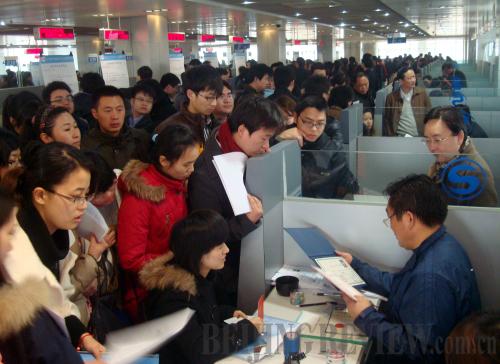|
 |
|
HOT POSITIONS: Job hunters pack a job fair for public institutions in Suzhou, Jiangsu Province, on February 27 (XINHUA) |
According to the reform program, China is planning to transform public institutions that perform administrative functions into government agencies under strict supervision, while those conducting for-profit, commercial activities will become full-fledged enterprises. Those with inadequate or ambiguous functions will be eliminated or merged into other organizations.
"Meanwhile, public institutions engaging in social services should strengthen their functions," said Song Shiming, another professor at the Chinese Academy of Governance. "These government-sponsored institutions will be prohibited from performing commercial activities."
The reform would facilitate China's efforts to forge a service-oriented government and improve the overall quality and quantity of public service programs, Song said.
After the reform, he said, public institutions would be defined as those that provide essential social services.
"The move seeks to address various problems in the current work of public institutions. It reflects the government's resolution to address public complaints over inadequate access to public services, such as education and healthcare," said Wu Jiang, Director of the Chinese Academy of Personnel Science, a think-tank under the Ministry of Human Resources and Social Security.
The general goal of the reform is to establish a system by the end of 2020, under which non-profit institutions will effectively operate to provide public services that people have equal access to.
For a long time, individuals recruited by public institutions are known for having an 'iron rice bowl,' namely a regular salary and tenure until retirement, regardless of performance.
"After the reform, the staff members of public institutions will have no iron rice bowl in the future, and their salaries will be determined according to their work results," Wu told Xinhua News Agency.
Besides financing public institutions, the government would also widen the doors for social investment to run non-profit institutions, like nurseries, primary schools, clinics and hospitals, Wu said.
"Public service institutions, like schools and hospitals, were almost all government-run in the past. In the future, they will be run by the whole society under government regulations," he said.
Private schools, universities and hospitals have been increasing in China, but are still far from being popular options for people. Most private institutions lack enough policy and financial support and cannot afford to obtain advanced equipment and talented people.
Wu said the reform of public institutions would provide a great chance for China to evolve a completely new public service system. He expects the country to largely increase its support for privately-run, non-profit institutions.
Meanwhile, Wang said more emphasis should be put on fairness in the process of the reform of public institutions.
"Fairness is the most important point in the reform, which will require the government to clarify its top responsibility, adjust the key areas of public investment, and establish a payment transfer system and a rational supervision framework," he said.
"Along with the reform, a great number of employees will be squeezed out through a proper competitive procedure. Thus, an improved social security system will be vital for smoothing the process," he said.
"To avoid detours during the reform process, simultaneous reforms should be undertaken among administrative organs," Wang said.
According to him, the reform itself implies a parallel transformation of the government and the administrative system. The slow progress of the reform of public institutions in recent years is a reflection of the inadequate transformation of government functions.
"The two processes interact and weaken each other. In order to push the reform of public institutions, we need to start with government restructuring and administrative reform," said Wang.
"It involves many aspects such as personnel management, income distribution, social security and taxation policy. If even one of the above fails to function properly, others will be affected and the overall effectiveness of the reform will suffer," Wang said. "Therefore, public institution reform must be coordinated with other reforms, and combined with supporting measures."
Wang warned that the reform of public institutions, as an enormous systematic project, demanded further efforts beyond solving the problems of redundant labor and heavy fiscal burdens. "Importance should be attached to restructuring the remaining majority that provides public services," he said.
He said the government should adopt a clear strategy to build a fair and effective public service system, which will benefit most people, including those in rural areas and on the lowest rungs of the social ladder.
Public service providers should also follow the market rules of free entry and fair play, he said.
Public Institutions
Public institutions refer to public service organizations that are established by state organs or other organizations by using the state-owned assets for the purpose of engaging in activities involving education, science and technology, culture and hygiene. The institutions mainly include media organizations, publishing houses, public schools, hospitals and research institutes, which do not aim to produce profits. | 